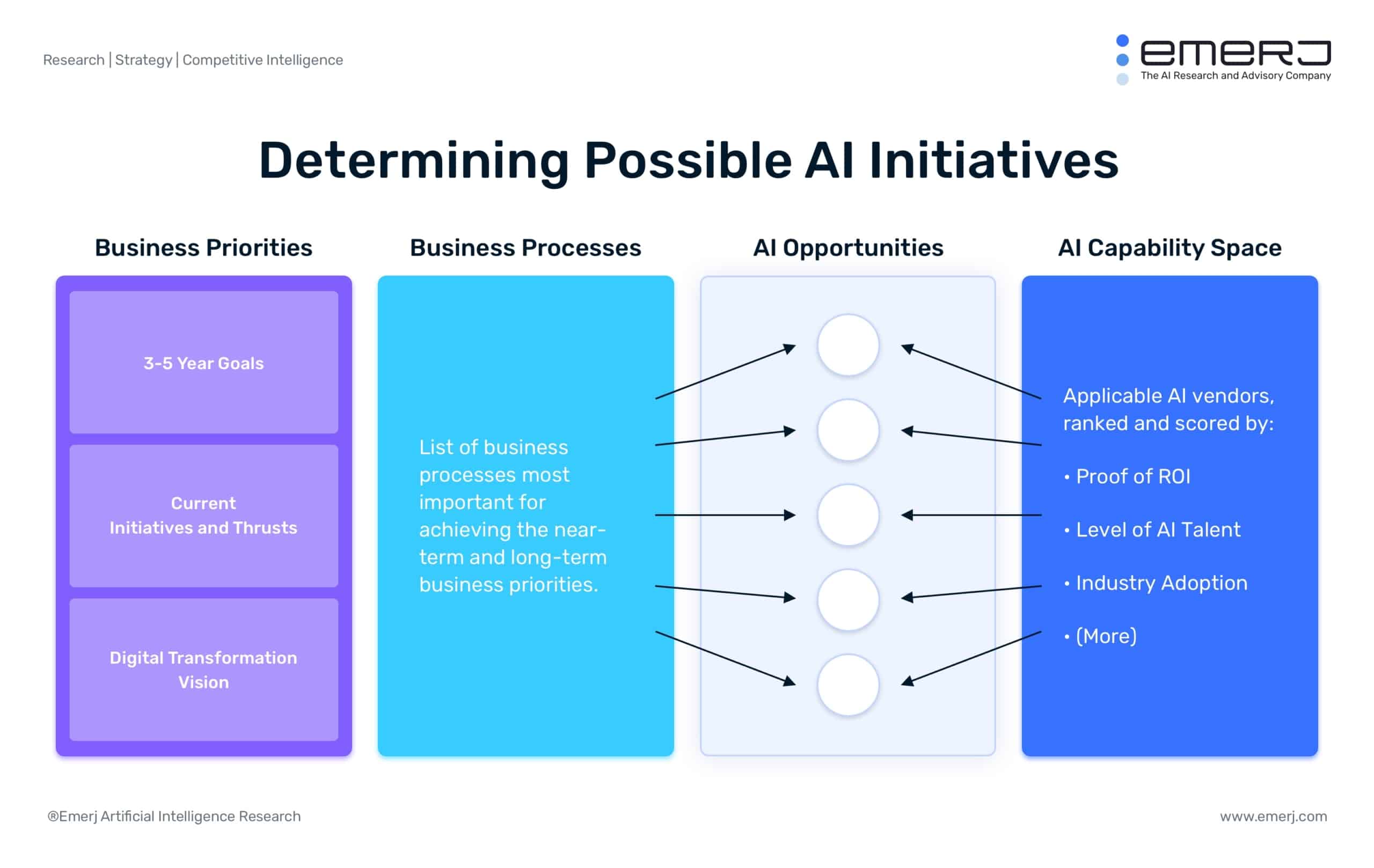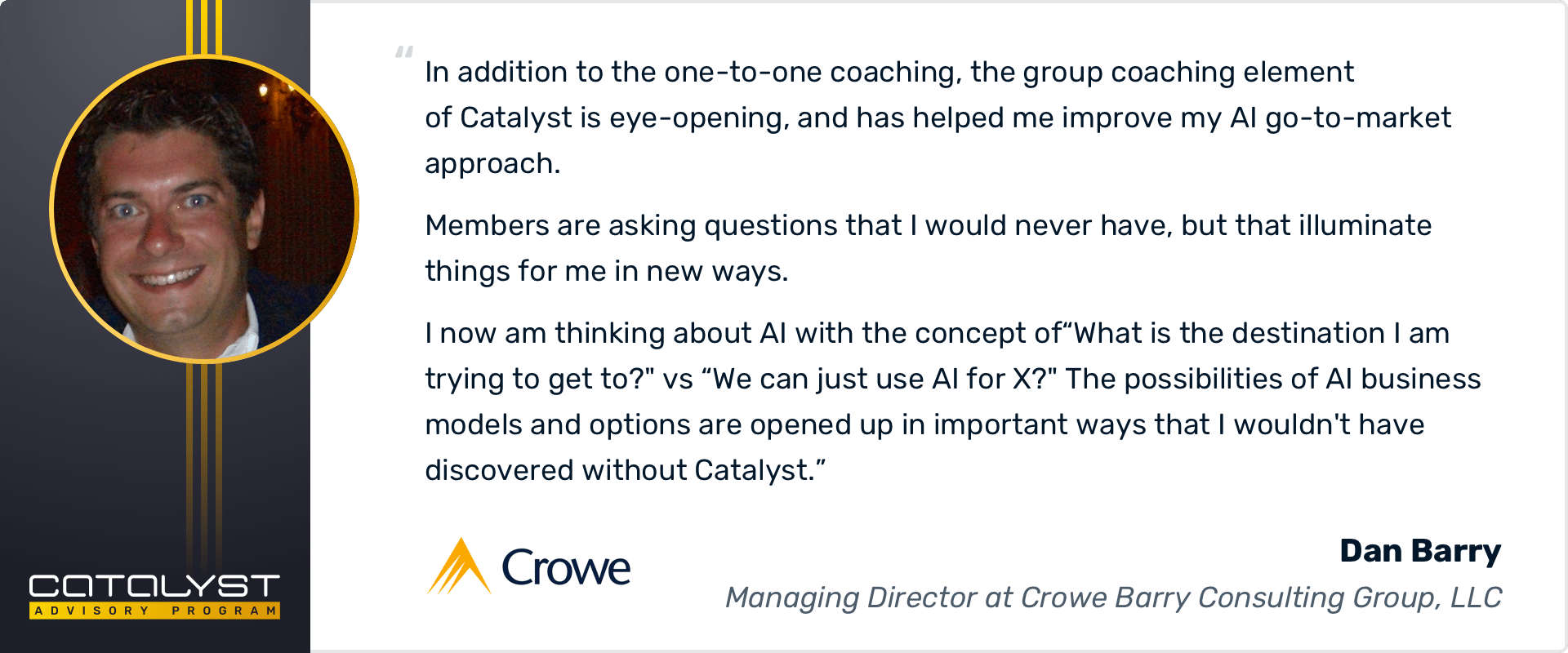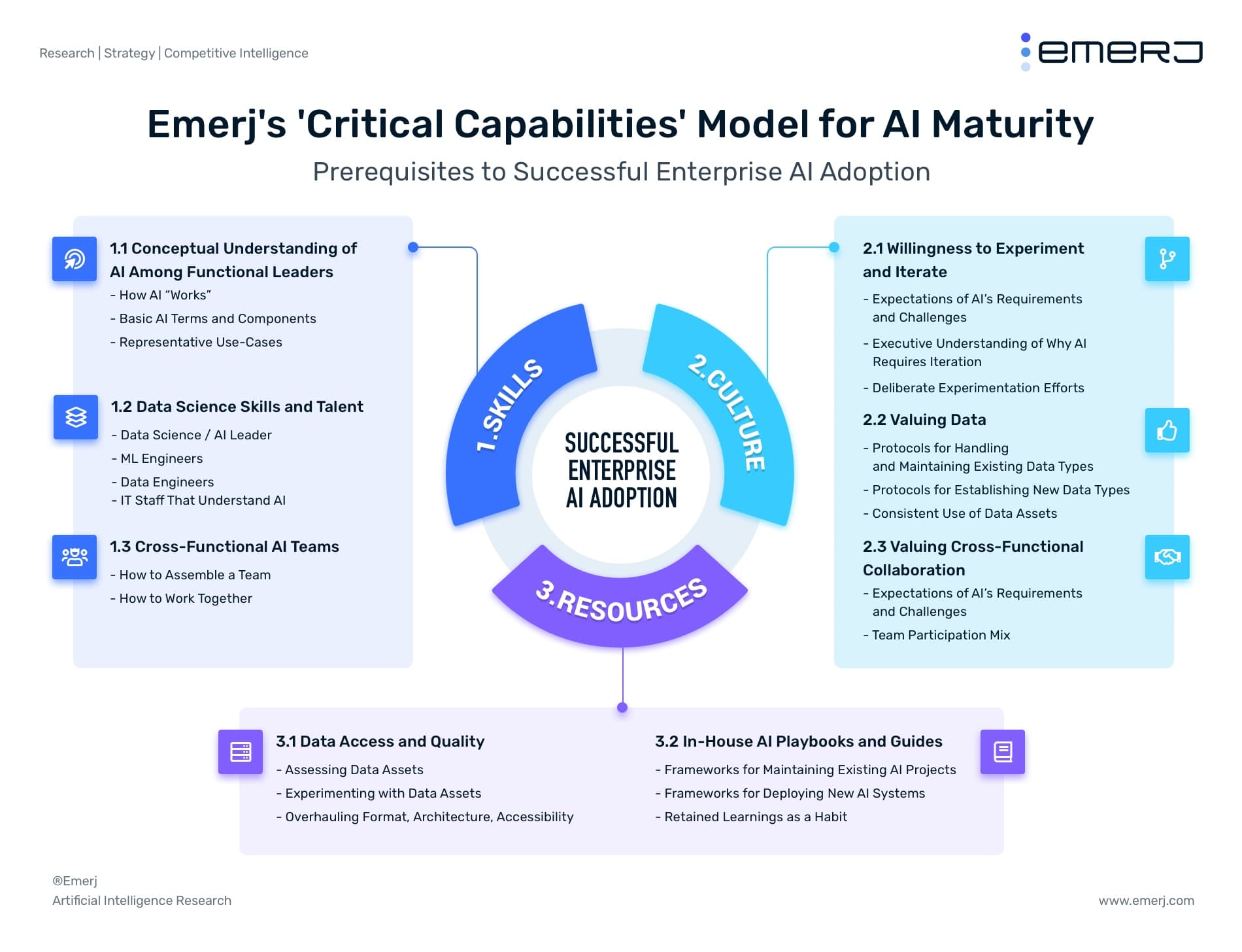While AI vendor companies proliferate in every sector, enterprises need much more than advanced technologies to actually adopt and deploy AI. AI services and consulting firms are expanding to fill the gap – offering services that enterprises often don’t have the in-house talent for, including:
- AI strategy development
- Data audits
- Custom development of AI tools and software
- Integration of AI and IT systems
- Vendor selection
- Executive AI education
Without recognized brands or massive marketing budgets, many small and mid-sized AI services firms need to win new business and compete in the market based on an intelligent go-to-market strategy – and that’s what I’ll be sharing in this article.
These lessons have been drawn from my hundreds of interviews with successful AI product and service companies, my hands-on experience working with enterprise strategy and procurement teams for AI projects, and my experience coaching AI consulting and services firms to greater success in our Catalyst Advisory Program.
For AI Consultants and Service Providers: This article will help you put together a stronger AI business case for enterprise clients, and focus on key skills you’ll need to develop long-term client relationships around AI strategy and AI initiatives.
For Enterprise Leaders: This article should prove useful in assessing which AI consulting and AI service vendors have their act together and genuinely understand your business problems, and which don’t.
I’ll begin with a visual breakdown of the four keys to selling AI services, and we’ll begin by discussing the importance of choosing your services range and market positioning:

1 – Determining Your Services Range and Market Positioning
The first key to selling AI services to the enterprise is determining the type of buyer you’ll serve. AI is a highly disruptive and oft-misunderstood technology, so it can be difficult to position your brand if you don’t know your target market well.
Enterprise buyers have varying levels of familiarity with AI. Some need education into the technology, some might be interested in being early adopters, while others have a thorough understanding of what kind of AI services or products they want for their business. The first thing you need to do to attract potential clients is to position your company in the market based on the services you offer.
What Services You Offer – and Don’t Offer
AI services can be divided into either technical or non-technical, or AI-related or not AI-related. The differences are quite significant.
Technical AI services involve the AI company taking an active role in implementing AI in an existing enterprise. This might be in the form of physically installing an AI-based product into a system, whether as stand-alone equipment, i.e. surgical robots, or integrating service-as-a-software (SaaS), i.e. tracking of diseases.
Non-technical AI services, on the other hand, would involve developing and/or marketing products that clients can use or install on their own without further interference by the service provider. An example of this would be most website chatbots, which anyone can integrate into their websites.
AI-related services primarily focus on AI as the defining factor in the offering, such as predictive analytics software. Non-AI-related services are those that may include AI capabilities but are not the main selling point for the service, such as Netflix.
You also need to define what services you white-label, sub-contract, or affiliate with. White-label services or products are those produced by companies other than yourself that you rebrand as your own, such as chatbots. Other services you might offer your clients might be performed by another company working under your brand, such as market research. In other cases, you might merely affiliate with another company to promote its services and products, such as in online education.
Value Proposition and Market Position
Determining your service range will help you formulate your unique value proposition and position your company for the right market. You will be able to hone in on the industry and size of company you serve based on the specific services you have, and promote your brand accordingly as the one enterprise should choose over other startups.
The purpose of defining your services and market position is to provide potential clients with a grounded understanding of the AI services you offer. It demystifies the concept of AI in any given situation. When you clearly state what you can do for enterprise in your particular niche, explaining the benefits of going with your brand becomes much easier, and so does marketing your brand.
2 – Matching Client Needs to AI Solutions Effectively

The second key is convincing potential clients that AI solutions can effectively satisfy client needs. You will need to first establish a potential client’s near and long-term aims in general. This would include finding out their goals for the next three to five years, so that will indicate the kind of AI services you offer the client might need at any point in business development.
You also need to find out what the client considers the strategic differentiators that distinguish the brand from competitors and current thrusts and initiatives that define the culture. Most importantly for providers of AI services, you need to find out the AI transformation vision that might drive their interest in your services. You can integrate the value of AI services in any of these aspects of enterprise strategies.
The trick is in identifying the full range of AI opportunities for each potential client. This is necessarily a customized proposal depending on the client’s circumstances and goals, but you need to focus particularly on the ROI potential for each of these opportunities. It might be in terms of potential savings, ease of deployment (depending on the existing infrastructure), higher productivity, more efficiency, or increased revenue. The ROI potential is your selling point when proposing an AI services project to the enterprise.
Address Existing Pains and Priorities
You can make all the proposals and pitches you want. You would still be wasting your time if you fail to convey a feeling or urgency and relevance to the client.
The best way to make your AI solution appealing is to address the pain points for each industry that AI technology can solve. You have to show that your products or services can address these issues and adapt to changes in real-time to benefit enterprises.

3 – Making the Business Case for AI
You need to understand that enterprises have a divide when it comes to AI adoption. In most cases, technical leaders (head of technology, head of IT) are primarily concerned with solving technical problems, and would be more or less knowledgeable about the technical benefits of AI services. However, they do not have the final say when it comes to committing to the technology.
That power resides in functional leaders, who are the decision-makers in purchasing AI services, and they are concerned mainly about gaining a competitive advantage. As an AI services provider, making a business case for AI is about conveying the return on investment (ROI) of AI to stakeholders.
Conveying the ROI of AI
The truth is most AI projects fail to show adequate ROI for enterprises because there is a lack of understanding of the many ways AI can benefit a business. In most cases, enterprise leaders equate ROI with short term financial returns.
Most leaders don’t know how to properly establish expectations, measurements, and frameworks for AI ROI because they simply haven’t had the chance to try. Technical leaders will more likely appreciate the strategic ROI of AI services in the long term when guided by experts.
When selling AI services to the enterprise, you will have to effectively frame the ROI of AI by discovering the most critical hurdles to near-term ROI for a prospective client, and best practices for deciding on AI projects based on their ROI potential in the long term. You can break this down to strategic ROI, capability ROI, and measurable ROI.
Strategic ROI delivers short and long-term results based on the core business priorities, and involves an in-depth understanding of business operations and goals. This will enable you to align AI initiatives to an AI advantage now – and into the future.
Capability ROI explores the versatility of AI services in business applications. Often, you can position the services you offer to benefit two or more aspects of the business, i.e. predictive analysis for both maintenance and sales.
Measurable ROI provides the client with anchor points that will demonstrate the six categories wherein any AI project can produce returns to the enterprise. This will help you set up the case to overcome many of the early hurdles that AI initiatives face.
Presenting the Business Case to Stakeholders
All these essential ROI points can work to your advantage if you can present the business case effectively to stakeholders. You need to understand that stakeholders will have varying levels of technical understanding, so you have to explain it in such a way that you effectively convey the benefits of AI without getting the message lost in technical jargon. You want to catch their attention, and hold it.
You should frame your pitch in such a way that non-technical (often functional) executives can understand it and still excite technical leaders to the point of recommending its purchase. The key is to emphasize team collaboration and alignment, and this might include a walk-through of key team collaboration points across the six phases of AI deployment.
4 – Delivering Value with AI Services
The first wave of enterprise software to hit the mainstream focused on selling features, lauding the architecture, and maximizing potential ROI. The problem with AI is it is often not a standalone solution. It needs to integrate with other technologies, and that can be difficult for many executives to understand. You need to be able to speak fluently about AI in terms of real-world applications, and not simply listing features to impress the customer.
It is about selling vision and value, with emphasis on value.
Setting Expectations About Delivering Value
Vendors of AI technology are often incentivized to make their technology sound more capable than it is – but to hint at more real-world traction than they actually have. The broader dynamics of how AI can be applied in business are rarely discussed in-depth, and this can hurt you in the end.
To normalize the adoption of AI services in enterprise, you need to set the record straight right from the start. AI services are seldom one-offs—you are in for the long haul. You want to set realistic expectations about the value of an AI service even if it means you might not win a project. The benefits of this shift in attitude in selling AI services are two-fold: protection and reputation.
By setting realistic expectations right from the start, you protect yourself from blowback. If you promise more than you can deliver, you will have to do a lot of explaining when the AI project fails to achieve expected results. You can avoid that and a lot of disappointed stakeholders.
When you are upfront about what AI can do for an enterprise, you also gain credibility with your clients and a reputation for being honest. You are building a sustainable relationship with your clients, signaling that you are committed and that you’re in it through the many phases of implementing AI, providing support whenever needed. You not only gain the confidence of your existing clients, you are more likely to get more referrals.
Building AI Maturity Through AI Projects

Selling AI services to novice enterprise owners is just the first step to significant AI adoption. Failure of a company to achieve AI maturity will lead to failure of initial AI projects, and you don’t want that.
In order to nudge enterprises into the AI maturity framework, you need to understand the five stages of maturity that will enable an enterprise to work smarter with AI. This involves getting many aspects of enterprise, namely people, data, strategy, technology, and governance, through exploration, experimentation, formalization, optimization, and transformation with AI.
If that sounds like a tall order, you would be right. However, the effort would be worth it in the end as it will develop the value of AI in enterprises in deep and significant ways across the board. The result is enterprises under your wing change from early adopters to enthusiastic advocates.
Expanding AI Services Through Iteration
AI is a disruptive technology for both sides of the equation. Enterprises and AI services providers are learning as they go along, and this can lead to an expansion of the scope and capabilities of AI. However, it is very much a digital frontier in the sense that adoption outside of the strictly technological sectors is often experimental. Things can go very wrong, very fast.
As an AI services provider, you need to expand your services in line with what works, and trim off what does not. Iteration does not only reveal flaws in AI services itself, but also problems with deployment and integration. In many cases, AI projects fail because there was not enough support for training and reframing of existing systems.
AI Consulting Success, Simplified
The Catalyst Advisory Program is designed to help you start and grow your AI consulting or services business, by learning the best practices of selling AI and delivering AI results for clients.
Here’s what other Catalyst members have had to say about the value of the program:

Don’t start your consulting journey alone – get 1-on-1 guidance and access to proven frameworks to get you up and running quickly – without reinventing the wheel.
Learn more about the Catalyst Advisory Program at: www.emerj.com/catalyst, or apply today via our online application form.


















